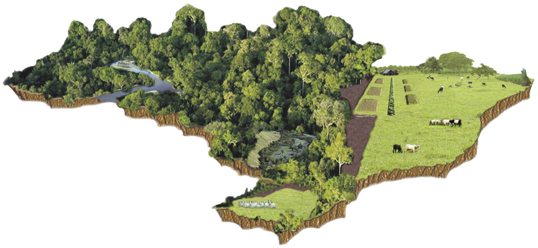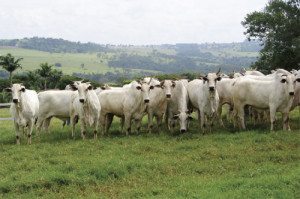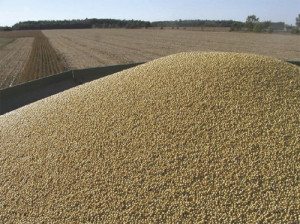""""[vc_column_text]Twenty years after the original Earth Summit (Eco 92), a diminished number of world leaders reconvened again in Rio de Janeiro, from June 20-22 for the United Nations Conference on Sustainable Development (Rio+20). The earlier event promoted a radical ecological agenda based on many myths about the environment. At this year’s summit, the Plinio Corrêa de Oliveira Institute is in Rio where it is presenting a study exposing the myths about the environment. The text of the study follows:1
About Environmentalism:
Did you know that…
An Embrapa survey illustrated on this map shows that only 810,814 of the 3,281,868 square miles of the Brazilian territory is used by urban and industrial areas, road structures, agriculture and cattle-raising, forestry and mining activities in general. That is only 25% of the country.
In God’s designs, natural resources are there to be exploited rationally. In Genesis, the Holy Scripture says: “And God created man to his own image: to the image of God he created him: male and female he created them. And God blessed them, saying: Increase and multiply, and fill the earth, and subdue it, and rule over the fishes of the sea, and the fowls of the air, and all living creatures that move upon the earth. And God said: Behold I have given you every herb bearing seed upon the earth, and all trees that have in themselves seed of their own kind, to be your meat.”2 The Brazilian territory is not a botanical garden or a zoo. It needs to be developed and exploited wisely, harmonizing the development of agriculture with environmental preservation.
A False Dilemma: Agriculture & Cattle-raising v. the Environment
Did you know that…
● ecologically, Brazil is one of the world’s best preserved countries and still keeps 69% of its natural vegetation and 28.3% of the earth’s original forests?
● the Amazon region has preserved 86% of its native vegetation; the Pantanal region, 80%?
● Brazil has the largest protected area in the world? That among national parks, reservations and Indian lands, protected areas now occupy 30% of the country, while the world average is 10%?
● in 2008, the world’s emissions of carbon from fossil fuels totaled 31.5 billion tons. China accounted for 21% of global emissions (6.5 billion tons), followed by the United States (19%), Russia (5.5%), India (4.8%) and Japan (3.9%)? That these five countries accounted for 53.4% of planetary emissions? And that Brazil — the world’s fifth largest country — accounted for only 1.4%?
● agriculture plays a huge role in environmental preservation? That it provides solutions to water conservation and biodiversity? That in addition to food and fiber, it guarantees one of the world’s cleanest energy sources? That 47.3% of Brazilian electric power comes from renewable sources (sugarcane-powered, hydro-powered, wood-powered and biodiesel-powered mills), compared to a world average of 18.6%?
● between 1976 and 2010, grain production in Brazil increased by 273% while the planted area increased by only 27%? And that this means that on the same acre of land, Brazilian farmers produced, on average, two and a half times more corn, wheat, rice, soybeans and beans?
● In 1970, a Brazilian farmer produced food for 73 people and that in 2010 that number jumped to 155 people?
● Sustainability is a technical issue, not one of belief or goodwill? That thanks to steady productivity gains, in 30 years Brazil ceased to be a food importer to become one of the world’s largest exporters of agricultural products?
Therefore, to frame agriculture and cattle-raising as enemies of the environment is to create a false dilemma. Not only is agricultural development compatible with preserving the environment but it has been playing an irreplaceable role in this task.
An Historic Moment in Agriculture
Did you know that…
● the Brazilian farmer is a hero? That despite all the ideological persecution, he has put Brazilian agriculture on the world stage as a vast storehouse for the future?
● he feeds our population with plentiful and increasingly inexpensive food? Moreover, that he produces a surplus, making our country the second largest grain exporter in the world?
● he produces 75% of all orange juice sold in the world and 40% of all coffee? That he is the biggest exporter of soybeans in the world? That he is responsible for 40% of all sugar exported in the world and produces the equivalent of 500,000 barrels of ethanol per day?
● he owns the world’s largest commercial cattle herd; is the world’s largest beef exporter and the second and third largest exporter of pork and poultry?
● he employs about 17 million people and is expected to generate over 6 million jobs, or 34% of the jobs that will be generated throughout the Brazilian economy from 2010 to 2022?
● he is responsible for a trade surplus of over $400 billion dollars over 10 years? And that thanks to agriculture and cattle-raising, not only has Brazil paid back the IMF, but it has built up foreign currency reserves of $300 billion dollars, and, all things considered, is weathering relatively well the economic crisis plaguing most of the world?
● according to FAO,3 Brazil is the country with the greatest potential for agricultural growth in the world? And that it is the country that can best meet global food needs over the next 40 years?
● between 1975 and 2005, in the city of São Paulo the cost of an average supermarket food cart fell over 5% per year in real terms? That an average Brazilian family used to spend 48% of their income on food and now spends only about 20%? That all this is thanks to technological progress in the field of agriculture and its practical application by Brazilian farmers?
● our farmer is responsible for the rise of many people from the lower to the middle class? That thirty years ago, minimum wages bought 70% of a food cart; but that today the same wages buys two carts worth of food? That as a result, the middle and working classes were not only able to consume more and better food but increased their buying power so as to be able to acquire industrial products as well?
Therefore, it is unacceptable for Brazil, which already has the world’s largest conservation area, to curtail its production capacity and thus reduce its ability to help fight poverty worldwide.
Thus we would like to know, why are Brazilian farmers persecuted so much? Do you know why?
The Myths of “Environmentalism”
Did you know that…
● global warming is a myth with no scientific basis? That it is disputed by the world’s most renowned scientists? That climate change’s track record disproves CO2-related warming?
● CO2 is the gas of life? That it produces neither pollution nor the trumped-up greenhouse effect? That it is a natural gas responsible for plant growth? That if CO2 were eliminated from the atmosphere, all life on Earth would cease?
● with two eruptions in the 20th century, the earth’s volcanoes released more sulfur dioxide than the whole Industrial Revolution from the 19th century to this day?
● icy Greenland got its name because during the beneficial MWP (medieval warm period) it was once a “green land” where crops and pastures flourished? That actually, temperatures in Europe were once higher than they now are? That grapes were cultivated in northern England?
● a standing mammoth was found frozen in the glaciers of Siberia with remnants of grass between its teeth?
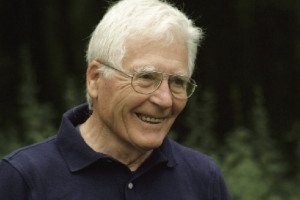
● James Lovelock, the father of the “Gaia hypothesis,” has recanted? That besides making his mea culpa, he has acknowledged that ecologists spread a false alarmism? That in 2006, Lovelock went so far as to say that billions of men would die before the end of the century and the few that would survive would remain in the Arctic, where the climate would still be tolerable? That now he admits that he went way too far? In his own words: “The problem is that we don’t know what the weather will do. Twenty years ago we thought we knew. This led us to write some alarmist books — including my own — because it seemed obvious, but it did not happen.”
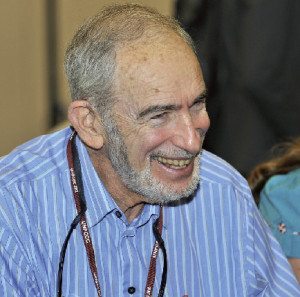
● the book, The Population Bomb, published by ecologist Paul Ehrlich in 1968, when the world population was 3.5 billion, predicted that, as a result of overpopulation hundreds of millions of people would starve to death in the following decades?
● Paul Ehrlich’s 1971 prediction that “by the year 2000 the United Kingdom will be merely a small group of impoverished islands inhabited by some 70 million hungry people” turned out to be false?
● the world population has doubled and the alarmist predictions of Malthus and Ehrlich never materialized? That instead, the percentage of undernourished people in developing countries, in relation to the total population, has shown a steady downward trend for four decades, dropping from 33% in 1970 to 16% in 2004? That this is thanks to new technologies and the exponential growth of productivity?[/vc_column_text][/vc_column][/vc_row]""[vc_column width=”1/2″][vc_column_text]● Arctic sea ice melted between 1920 and 1945, when man released into the atmosphere less than 10% of the carbon he now emits? That one cannot deny that global temperatures over the past 100 years have had a cyclical increase in the order of .7 °C? That this happened as a result of natural processes, not because of man’s impact on the amount of vegetation and the burning of fossil fuels?
● Prof. Henrik Svensmark stated: “In fact, global warming has stopped and a cooling period has started. No climate model had predicted this cooling of the earth, quite the contrary. This means that projections of future climate changes are not reliable.”
Consequently, we want to know what is the real reason behind this ecological panic that costs billions of dollars and, even worse, threatens to paralyze Brazil’s future and halt the enrichment of its population.[/vc_column_text][/vc_column][vc_column width=”1/2″][vc_single_image image=”15063″ img_size=”full” alignment=”center”][/vc_column][/vc_row]""""[vc_column_text]Environmentalism: a “New Religion?”
● The Earth Charter is intended to replace the Ten Commandments. Like a new Moses, former Soviet Prime Minister Gorbachev announced the Earth Charter: “It is the manifesto of a new ethics for the new world: the Ten Commandments of the New Age are the basis of a new, universal code of conduct which should rule the world from the year 2000. These new concepts should be applied to any system of ideas, morals and ethics and provide a new way of life. The mechanism we use is to replace the Ten Commandments with the principles contained in this Charter or Constitution of the Earth.”
● Deifying nature is the goal of pantheistic environmentalists. Mr. Jose Lutzemberg, former Secretary of the Environment and a leader among pantheistic environmentalists explains this concept in his article, “Gaia, The Living Planet” stating: “The difference between strictly scientific conventional biologists and environmentalists lies in what they venerate. For the environmentalist, nature is not simply an object of study and manipulation; it is much more: it is something divine. Do not be afraid of this word, nature is sacred. And we humans are just part of it.”
● Notorious environmentalists reveal their goals: socialism, egalitarianism, miserabilism, catastrophism and totalitarianism.
President Hugo Chavez of Venezuela: “Capitalist countries are the biggest climate assassins” (Statement at COP-16 in Cancun).
Evo Morales, President of Bolivia: “If we want to save the Earth and mankind, we have no alternative but to end the capitalist system” (Press conference at COP-15 in Copenhagen).
Geographer Carlos Walter Porto Gonçalves: “The ecological issue is central to the debate on Land Reform. Global warming creates a fantastic opportunity. The peasantry and indigenous peoples now acquire a central role in the debate on the future of humanity. All the evils we are experiencing derive from capitalism.”
Leonardo Boff, a former Franciscan friar, liberation theologian: “The wheel of global warming can no longer be stopped. As a set of ecosystems, the Earth has already become unsustainable because human consumption, especially by the squandering rich, has seen its renewable capacity drop below 40%. This situation can lead to an ecological and humanitarian disaster of unimaginable proportions and even to the disappearance of the human species by the end of the century” (Adital News Agency).
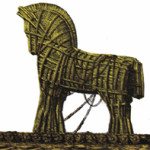
Will You Be Fooled by This Trojan Horse?
The huge wooden horse which the Greeks left as a gift to their Trojan enemies has become legendary. Yet it was no gift but a trap. Once inside the enemy city, the warriors hidden inside the contraption “dismounted” in the still of night and opened the gates of the fortress for the rest of the Greek army.
Today, radical ecology — which is proving itself to be a disturbing “environmental religion” — has unleashed an environmentalist psychosis in the hope of deceiving everyone. On the pretext of saving nature, this movement spreads lies, threatens the well being and legitimate enrichment of the Brazilian people, and compromises our country’s ability of supplying food to the world.
Even worse, by violating the right to private property, radical ecology tramples upon the rights of workers to possess the fruits of their labor.
Do you know who lurks behind these NGOs’ environmentalist paranoia? Do you know who hides inside this Trojan horse? Do you know what tools they employ to subvert society and destroy what still remains of Christian Civilization?
Do not be fooled by the new “green religion.” Read the book (in Portuguese):
Environmentalism:
Nature Conservation or Trojan Horse?
Considerations on Brazil’s New Forest Code
[/vc_column_text][/vc_column][/vc_row]""[vc_column width=”1/2″][vc_single_image image=”15065″ img_size=”medium” alignment=”center”][/vc_column][vc_column width=”1/2″][vc_single_image image=”15066″ img_size=”medium” alignment=”center”][/vc_column][/vc_row]
Footnotes
- All sources not already indicated here, can be found in the book Environmentalism: Nature Conservation or Trojan Horse? Considerations on Brazil’s New Forest Code. Click here for a PDF version of this book in Portuguese.
- Gen. 1: 27-29
- Food and Agriculture Organization of the United Nations


